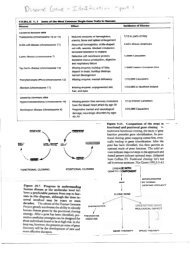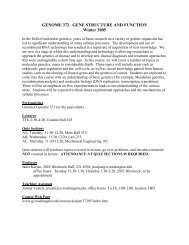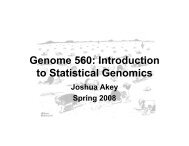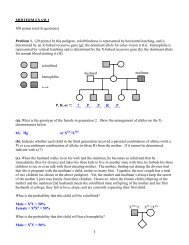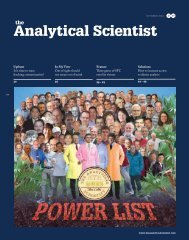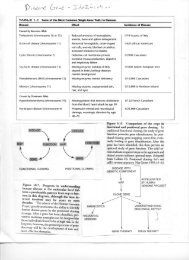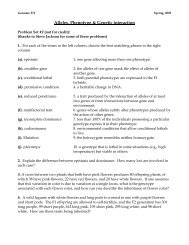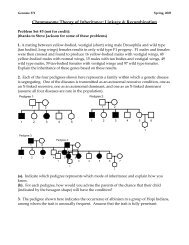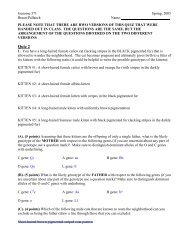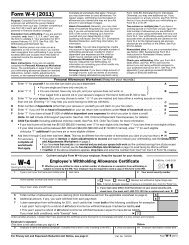Final Exam
Final Exam
Final Exam
Create successful ePaper yourself
Turn your PDF publications into a flip-book with our unique Google optimized e-Paper software.
and you call your mutant “TheOne”. You snap some pictures and draw some graphs and visit<br />
Professor Green.<br />
To your dismay, Professor Green has already started to cultivate some of the fast-growing lake<br />
algae and named it “Greenworm greenardii”. On the bright side, he has also isolated some<br />
interesting mutants and knows quite a bit about the algae’s biology and utility for biofuel<br />
production. He tells you that your mutant will be tough to harvest as it no longer responds to the<br />
signal that causes the algae to flock together. You decide to join forces and investigate the<br />
pathways controlling growth, flocculation, and mating. First, you catalogue all mutants, including<br />
your own (“TheOne”).<br />
1. “TheOne” aka Green1: recessive, divides mitotically, fails to flocculate, fails to form zygotes,<br />
highly light-sensitive, rare mating events allow for double mutant analysis, visible phenotype:<br />
has only one flagellum<br />
2. Green2: dominant, flocculates extremely fast after only one or two mitotic divisions, forms<br />
zygotes and flagellated offspring (i.e. mates continuously), light-sensitivity like wild-type, visible<br />
phenotype: 3 flagella<br />
3. Green3: recessive, cells do not flocculate but form zygotes when forced in close proximity,<br />
zygotes form flagellated offspring like wild-type, light-sensitivity like wild-type, visible phenotype:<br />
4 flagella<br />
4. Green4: recessive, divides mitotically, fails to flocculate, fails to form zygotes, light-sensitivity<br />
like wild-type, rare mating events allow for double mutant analysis, visible phenotype: 5 flagella<br />
5. Green5: dominant, cell flocculation and zygote formation is strongly decreased, unlike wildtype<br />
rare zygotes readily form flagellated offspring in dark and light conditions, insensitive to<br />
light in motility assays, visible phenotype: 6 flagella<br />
6. Green6: recessive, cell flocculation and zygote formation as in wild-type, zygotes fail to form<br />
flagellated offspring in the light and dark, rare offspring allows for double mutant analysis,<br />
insensitive to light in motility assays, visible phenotype: large, non-flagellated cells<br />
Your mutants still allow mating and offspring production, albeit at a very low frequency. What<br />
does this indicate? What complications arise for the subsequent double mutant analysis? If you<br />
could not rely on rare mating events, what approach would help you to genetically analyze this<br />
pathway(s)? What complications for double mutant analysis arise from using dominant mutants?<br />
How do you create recessive mutants of Green2 and Green5? How do you confirm that these<br />
mutants are in the same gene? What phenotypes do you expect in the respective recessive<br />
mutants if the original mutant represented a gain-of-function or a loss-of-function mutant?<br />
You decide on double mutant analysis to create a pathway(s) to explain these confusing<br />
phenotypes. Assume no complications due to escapees. Note that the visible flagellum<br />
phenotype is just a marker for your genotype and behaves additively for recessive mutants. This<br />
phenotype is unrelated to the pathway(s) that you study. Professor Green has phenotyped some<br />
double mutants already. Results are shown for an individual non-parental tetrad type (resulting<br />
in 2 cells containing the double mutant and 2 wild-type cells). For simplicity the respective wildtype<br />
cells and additional tetrads are not shown. Please fill in the “?” and predict pathway(s) that<br />
is consistent with your data and Prof. Green’s. Draw the pathway(s) and indicate the nodes<br />
corresponding to the mutants (see also Fig.1). Be specific.



